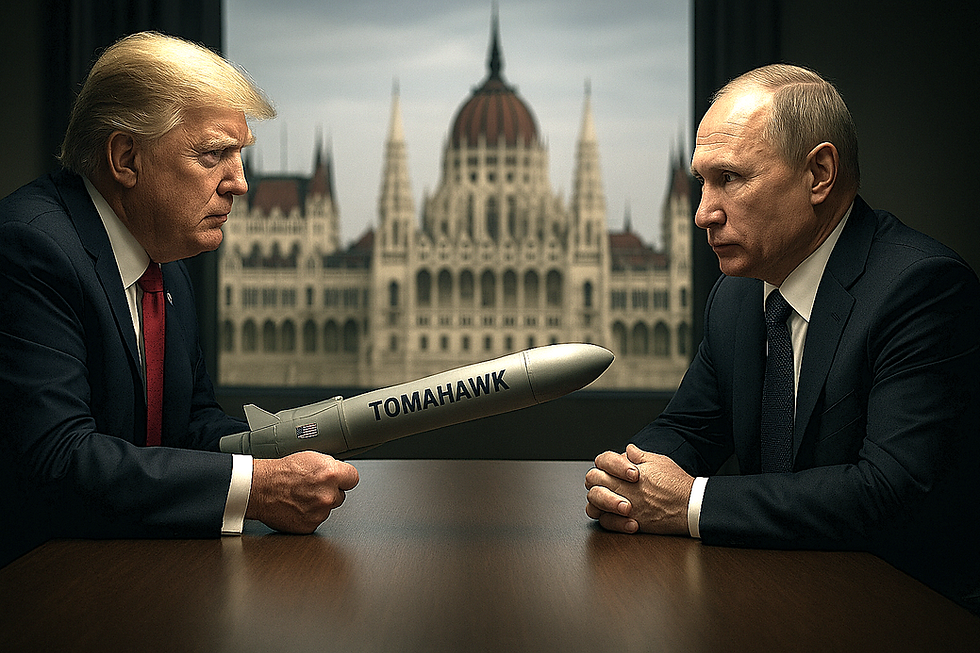How the Tomahawk Demand Crippled Ukraine Peace Talks with Russia?
- Teo Drinkovic
- 8 hours ago
- 4 min read
How a long-range weapon, frozen front lines, and strategic bargaining derailed a chance for peace in Ukraine and shifted the balance of diplomacy

Introduction
It seems that the fated meeting between President Donald Trump and President Vladimir Putin in Budapest is off, at least for now. Trump himself said he doesn’t want a wasted meeting with Putin and confirmed that talks about the war in Ukraine are, for the moment, canceled. The war and its horrors in Ukraine continue unabated: bombs still fall, people still die and get wounded, while politicians keep playing games. Opinions differ wildly on what exactly caused the meeting’s cancellation.
The U.S. Side and President Trump
From the American side, President Trump believes holding a meeting now would be useless and a complete waste of time. His reason: the Russian side has not accepted his proposal to freeze the frontline, that is, stop fighting along the current line of separation, and Moscow has remained firm on its demands without making concessions. In that situation, Trump concluded that a meeting for the sake of meeting simply shouldn’t happen.
At the same time, this sends both a foreign-policy and domestic signal: he is not a naive negotiator who will sit down without conditions; he holds the line that the meeting must make sense. If the meeting yields no progress, i.e., if Russia sticks to maximalist demands and Ukraine refuses major concessions, then the encounter would be “useless” and could weaken the position of the U.S. and Ukraine.
The Russian Side and President Putin
If you ask the Russian side why the meeting was postponed, their position is: “We are ready, but you (U.S./Ukraine/West) have not put forward conditions we consider acceptable. We will not hold a meeting now because we do not see it delivering the results we want. When conditions are at our level, then we will sit and talk.” That gives them time, position, and negotiating flexibility.

By accepting the postponement, Putin effectively signals that Russia is not forced to enter talks from a position of weakness. It keeps the option open to negotiate on its terms, not when the other side (the U.S.) pressures for timing. By rejecting the “front-freeze” or similar proposals, Russia sends a message to the West: we will not agree to de-escalation unless our demands are taken seriously; the West is, in fact, responsible for the delay because it puts unrealistic demands on Russia and ignores Russia’s wishes.
The Ukrainian Side and President Zelensky
Ukraine is the side that loses the most from this postponement: the war is fought on its territory, its infrastructure is being destroyed, and its people suffer the most. Because of that, President Volodymyr Zelensky is very interested in any form of negotiations that could bring Ukraine at least a temporary ceasefire or a short respite from the war’s devastation.
Even so, Ukraine has its red lines and conditions it will not cross at all costs. Upon mention of handing over any of the occupied territory to Russia, Ukrainians jump up and say: Not a millimeter of our land will we give away.

Zelensky and most Ukrainians believe the meeting was postponed precisely because the U.S. refused to deliver long-range Tomahawk missiles to Ukraine. Although Ukraine stressed it would not use the missiles against civilian targets in Russia and only for military objectives, the request was denied. That caused frustration and disappointment among Ukrainian military and civil circles, who believe that without long-range weapons they remain in a disadvantageous position against Russia, which continues to bomb when and where it pleases.
Ukrainian media echo this view: they say that Putin, as always, outplayed U.S. trust. When it became clear that the Tomahawks would not be delivered to Ukraine and therefore Ukraine could not threaten Russia in the way it hoped, Putin simply decided that no peace meeting was necessary.
Ukrainians believe that Putin, afraid of these long-range missiles and their effect on Russia, might have been forced to take a seat at the negotiating table, but once the threat disappeared, he walked away.
What’s Next
As we can see, each side in the conflict is pursuing its own policy, pulling in its own direction, and refusing compromise. The mediator, the U.S., also has its own interests, although admittedly, the U.S. is the only major actor attempting something about peace right now.
Each side accuses the other of sabotaging cease-fire efforts and peace talks, and no one seems willing to make the first move. The end of this war is no closer than it was a few years ago; no real peace process has yet begun.
Because of the entire domino effect this war has triggered, affecting the U.S., Europe, the NATO alliance, the United Nations, and the rest of the world, it would be good if the war ended tomorrow. And then there’s Russia’s nuclear power, which Putin has mentioned and threatened multiple times.
If he is pressured and finds himself cornered, who knows how he might react! All in all, yet another peace attempt has failed, and no next one is in sight in the near future. Let’s hope at least that President Trump won’t simply wash his hands of a cease-fire in Ukraine and the achievement of lasting peace.






Feel free to comment!